Management assignment
VerifiedAdded on 2022/11/24
|12
|2957
|262
AI Summary
This article discusses the principles of supply chain management and their relevance in achieving sustainable growth. It addresses key issues in the supply chain framework and proposes strategies for managing consumer demographics, restructuring logistic networks, and incorporating technological disruptions. The article also highlights the importance of market signal identification, product differentiation, and management of supply sources. It concludes by discussing the contribution of the article and its future scope.
Contribute Materials
Your contribution can guide someone’s learning journey. Share your
documents today.
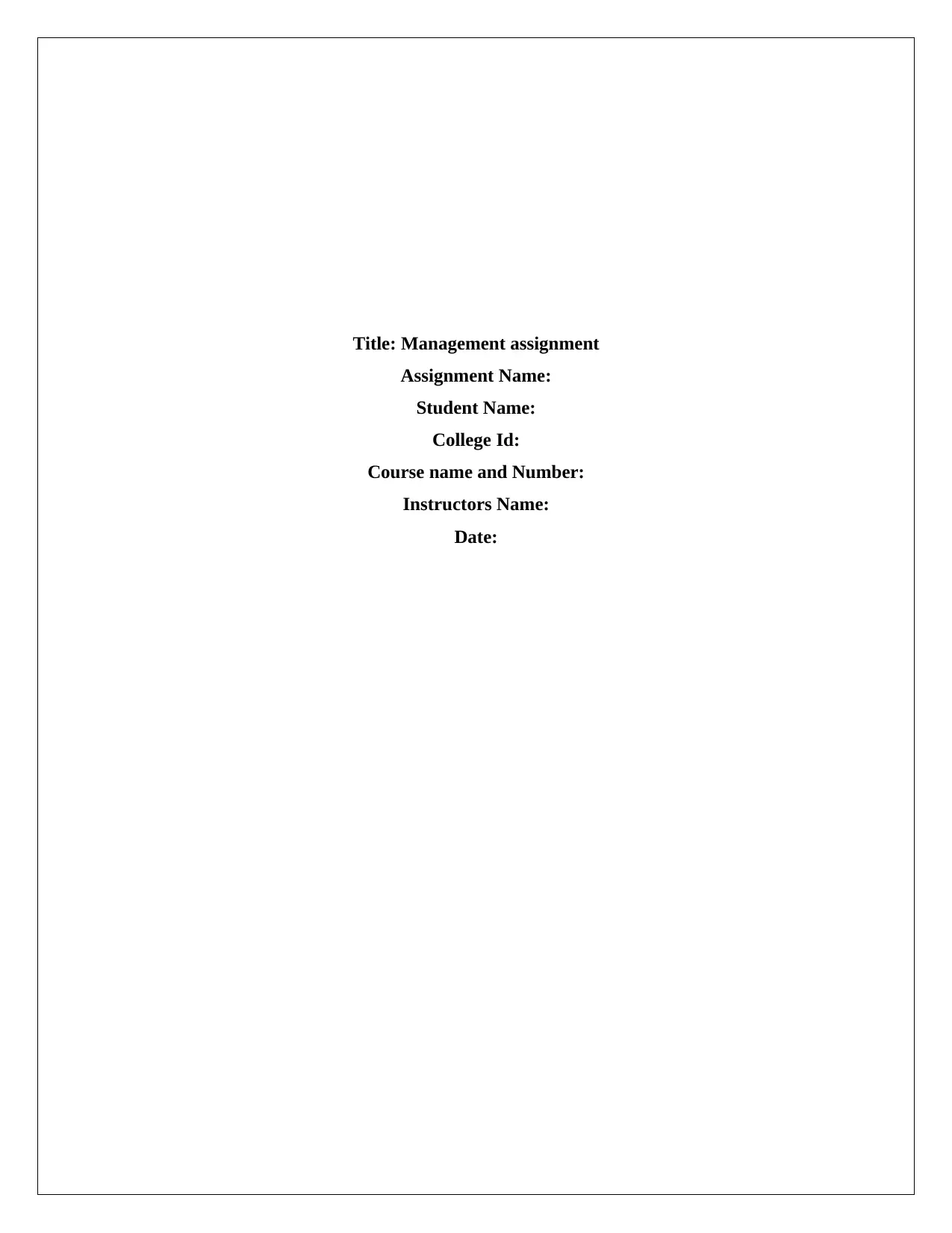
Title: Management assignment
Assignment Name:
Student Name:
College Id:
Course name and Number:
Instructors Name:
Date:
Assignment Name:
Student Name:
College Id:
Course name and Number:
Instructors Name:
Date:
Secure Best Marks with AI Grader
Need help grading? Try our AI Grader for instant feedback on your assignments.
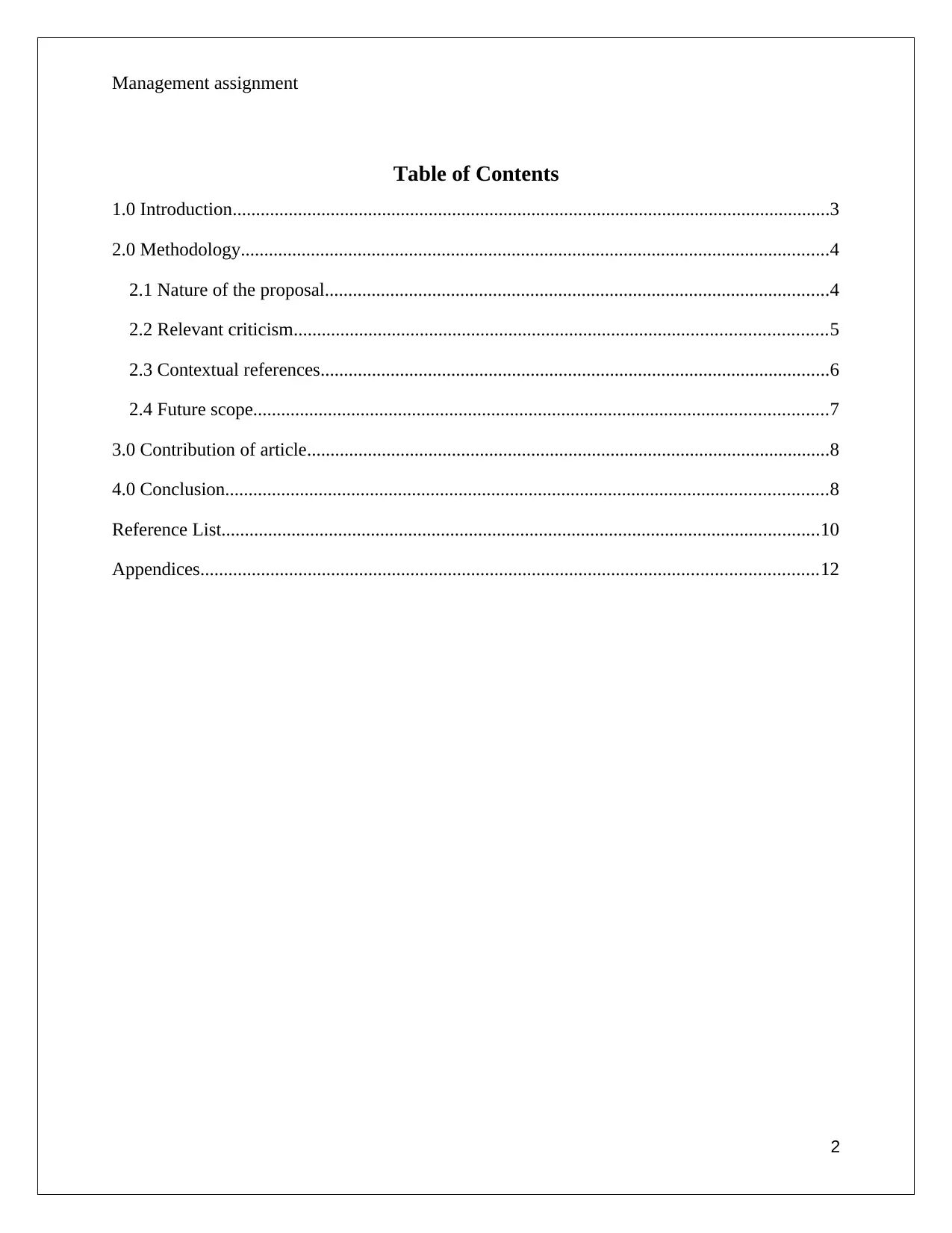
Management assignment
Table of Contents
1.0 Introduction................................................................................................................................3
2.0 Methodology..............................................................................................................................4
2.1 Nature of the proposal............................................................................................................4
2.2 Relevant criticism..................................................................................................................5
2.3 Contextual references.............................................................................................................6
2.4 Future scope...........................................................................................................................7
3.0 Contribution of article................................................................................................................8
4.0 Conclusion.................................................................................................................................8
Reference List................................................................................................................................10
Appendices....................................................................................................................................12
2
Table of Contents
1.0 Introduction................................................................................................................................3
2.0 Methodology..............................................................................................................................4
2.1 Nature of the proposal............................................................................................................4
2.2 Relevant criticism..................................................................................................................5
2.3 Contextual references.............................................................................................................6
2.4 Future scope...........................................................................................................................7
3.0 Contribution of article................................................................................................................8
4.0 Conclusion.................................................................................................................................8
Reference List................................................................................................................................10
Appendices....................................................................................................................................12
2
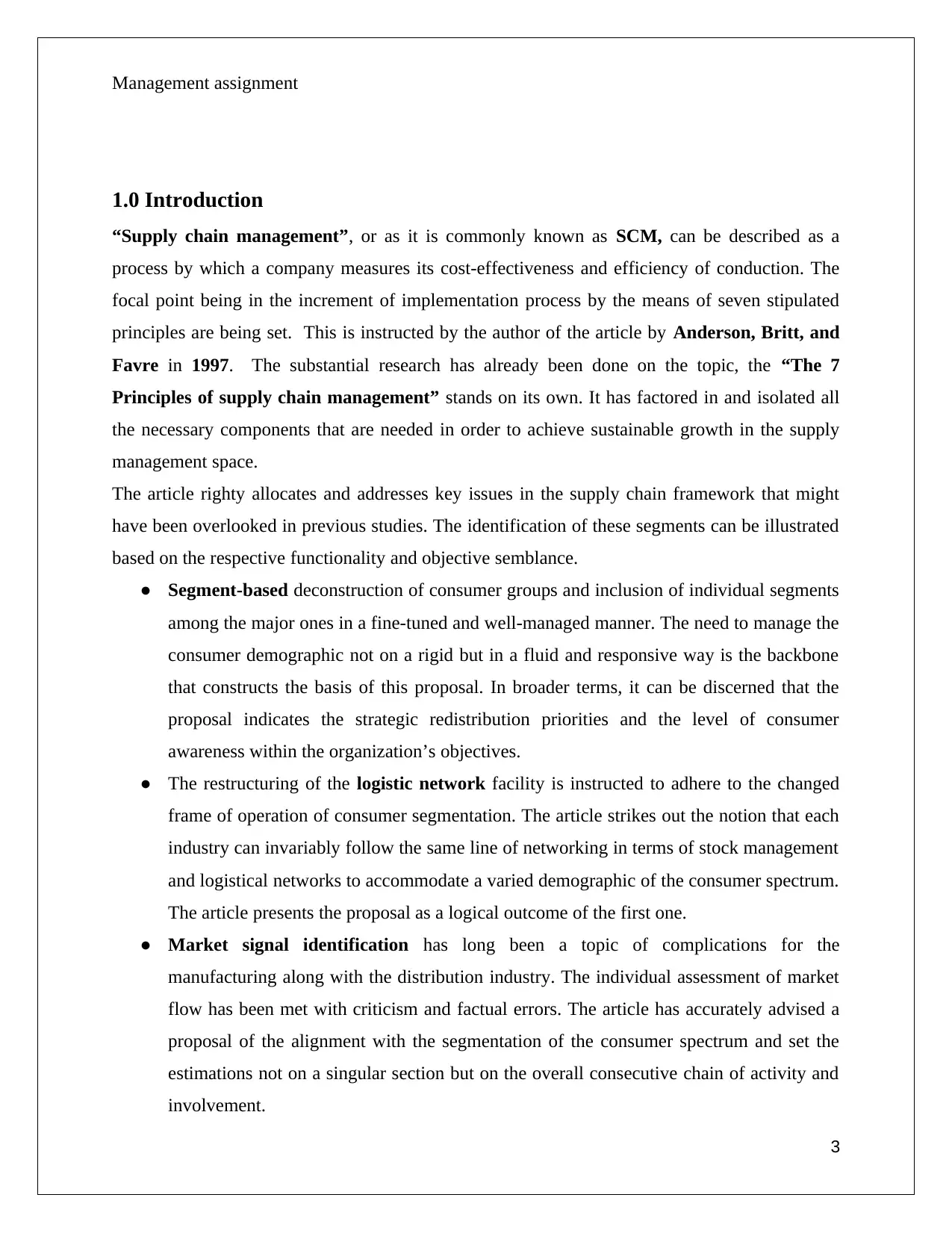
Management assignment
1.0 Introduction
“Supply chain management”, or as it is commonly known as SCM, can be described as a
process by which a company measures its cost-effectiveness and efficiency of conduction. The
focal point being in the increment of implementation process by the means of seven stipulated
principles are being set. This is instructed by the author of the article by Anderson, Britt, and
Favre in 1997. The substantial research has already been done on the topic, the “The 7
Principles of supply chain management” stands on its own. It has factored in and isolated all
the necessary components that are needed in order to achieve sustainable growth in the supply
management space.
The article righty allocates and addresses key issues in the supply chain framework that might
have been overlooked in previous studies. The identification of these segments can be illustrated
based on the respective functionality and objective semblance.
● Segment-based deconstruction of consumer groups and inclusion of individual segments
among the major ones in a fine-tuned and well-managed manner. The need to manage the
consumer demographic not on a rigid but in a fluid and responsive way is the backbone
that constructs the basis of this proposal. In broader terms, it can be discerned that the
proposal indicates the strategic redistribution priorities and the level of consumer
awareness within the organization’s objectives.
● The restructuring of the logistic network facility is instructed to adhere to the changed
frame of operation of consumer segmentation. The article strikes out the notion that each
industry can invariably follow the same line of networking in terms of stock management
and logistical networks to accommodate a varied demographic of the consumer spectrum.
The article presents the proposal as a logical outcome of the first one.
● Market signal identification has long been a topic of complications for the
manufacturing along with the distribution industry. The individual assessment of market
flow has been met with criticism and factual errors. The article has accurately advised a
proposal of the alignment with the segmentation of the consumer spectrum and set the
estimations not on a singular section but on the overall consecutive chain of activity and
involvement.
3
1.0 Introduction
“Supply chain management”, or as it is commonly known as SCM, can be described as a
process by which a company measures its cost-effectiveness and efficiency of conduction. The
focal point being in the increment of implementation process by the means of seven stipulated
principles are being set. This is instructed by the author of the article by Anderson, Britt, and
Favre in 1997. The substantial research has already been done on the topic, the “The 7
Principles of supply chain management” stands on its own. It has factored in and isolated all
the necessary components that are needed in order to achieve sustainable growth in the supply
management space.
The article righty allocates and addresses key issues in the supply chain framework that might
have been overlooked in previous studies. The identification of these segments can be illustrated
based on the respective functionality and objective semblance.
● Segment-based deconstruction of consumer groups and inclusion of individual segments
among the major ones in a fine-tuned and well-managed manner. The need to manage the
consumer demographic not on a rigid but in a fluid and responsive way is the backbone
that constructs the basis of this proposal. In broader terms, it can be discerned that the
proposal indicates the strategic redistribution priorities and the level of consumer
awareness within the organization’s objectives.
● The restructuring of the logistic network facility is instructed to adhere to the changed
frame of operation of consumer segmentation. The article strikes out the notion that each
industry can invariably follow the same line of networking in terms of stock management
and logistical networks to accommodate a varied demographic of the consumer spectrum.
The article presents the proposal as a logical outcome of the first one.
● Market signal identification has long been a topic of complications for the
manufacturing along with the distribution industry. The individual assessment of market
flow has been met with criticism and factual errors. The article has accurately advised a
proposal of the alignment with the segmentation of the consumer spectrum and set the
estimations not on a singular section but on the overall consecutive chain of activity and
involvement.
3
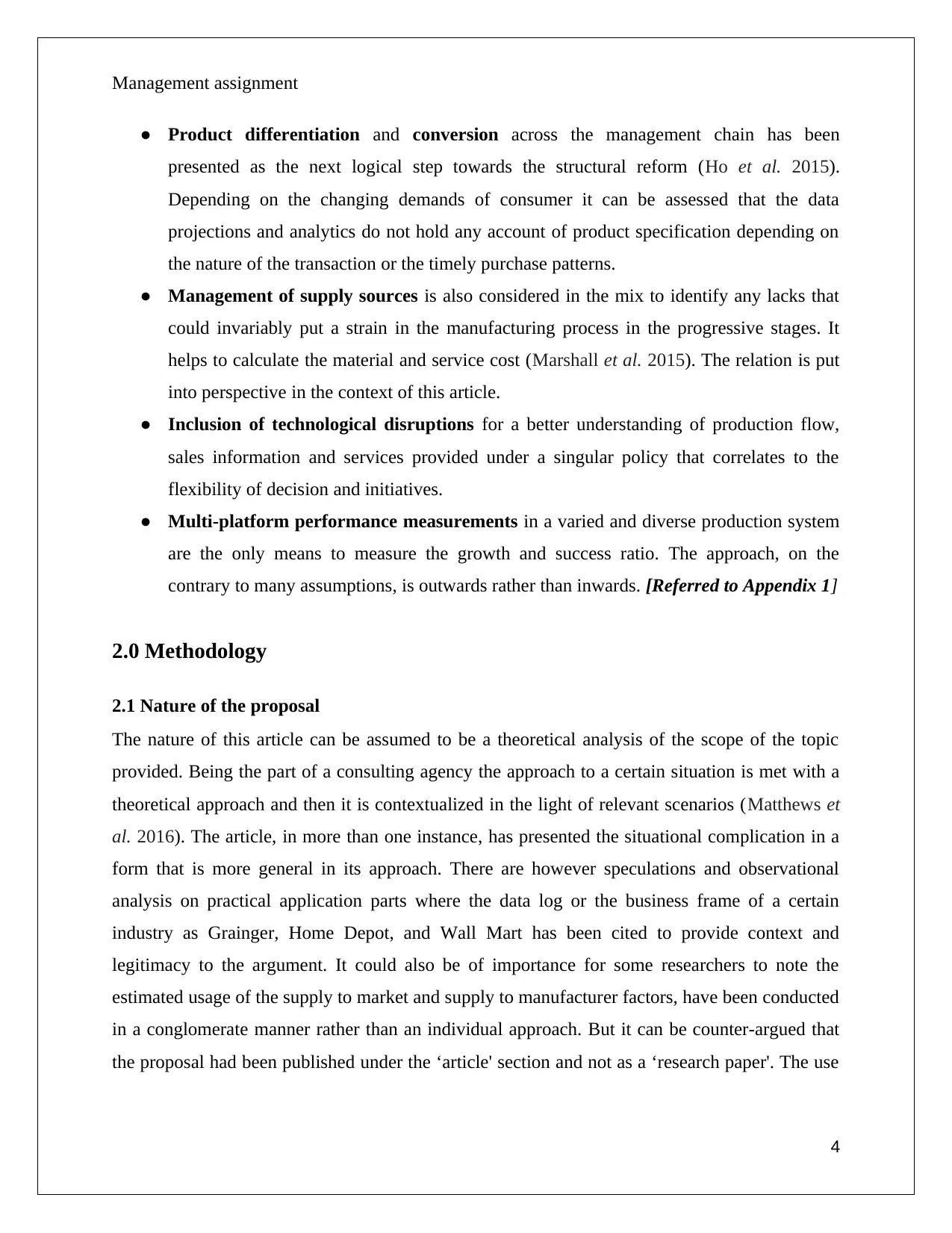
Management assignment
● Product differentiation and conversion across the management chain has been
presented as the next logical step towards the structural reform (Ho et al. 2015).
Depending on the changing demands of consumer it can be assessed that the data
projections and analytics do not hold any account of product specification depending on
the nature of the transaction or the timely purchase patterns.
● Management of supply sources is also considered in the mix to identify any lacks that
could invariably put a strain in the manufacturing process in the progressive stages. It
helps to calculate the material and service cost (Marshall et al. 2015). The relation is put
into perspective in the context of this article.
● Inclusion of technological disruptions for a better understanding of production flow,
sales information and services provided under a singular policy that correlates to the
flexibility of decision and initiatives.
● Multi-platform performance measurements in a varied and diverse production system
are the only means to measure the growth and success ratio. The approach, on the
contrary to many assumptions, is outwards rather than inwards. [Referred to Appendix 1]
2.0 Methodology
2.1 Nature of the proposal
The nature of this article can be assumed to be a theoretical analysis of the scope of the topic
provided. Being the part of a consulting agency the approach to a certain situation is met with a
theoretical approach and then it is contextualized in the light of relevant scenarios (Matthews et
al. 2016). The article, in more than one instance, has presented the situational complication in a
form that is more general in its approach. There are however speculations and observational
analysis on practical application parts where the data log or the business frame of a certain
industry as Grainger, Home Depot, and Wall Mart has been cited to provide context and
legitimacy to the argument. It could also be of importance for some researchers to note the
estimated usage of the supply to market and supply to manufacturer factors, have been conducted
in a conglomerate manner rather than an individual approach. But it can be counter-argued that
the proposal had been published under the ‘article' section and not as a ‘research paper'. The use
4
● Product differentiation and conversion across the management chain has been
presented as the next logical step towards the structural reform (Ho et al. 2015).
Depending on the changing demands of consumer it can be assessed that the data
projections and analytics do not hold any account of product specification depending on
the nature of the transaction or the timely purchase patterns.
● Management of supply sources is also considered in the mix to identify any lacks that
could invariably put a strain in the manufacturing process in the progressive stages. It
helps to calculate the material and service cost (Marshall et al. 2015). The relation is put
into perspective in the context of this article.
● Inclusion of technological disruptions for a better understanding of production flow,
sales information and services provided under a singular policy that correlates to the
flexibility of decision and initiatives.
● Multi-platform performance measurements in a varied and diverse production system
are the only means to measure the growth and success ratio. The approach, on the
contrary to many assumptions, is outwards rather than inwards. [Referred to Appendix 1]
2.0 Methodology
2.1 Nature of the proposal
The nature of this article can be assumed to be a theoretical analysis of the scope of the topic
provided. Being the part of a consulting agency the approach to a certain situation is met with a
theoretical approach and then it is contextualized in the light of relevant scenarios (Matthews et
al. 2016). The article, in more than one instance, has presented the situational complication in a
form that is more general in its approach. There are however speculations and observational
analysis on practical application parts where the data log or the business frame of a certain
industry as Grainger, Home Depot, and Wall Mart has been cited to provide context and
legitimacy to the argument. It could also be of importance for some researchers to note the
estimated usage of the supply to market and supply to manufacturer factors, have been conducted
in a conglomerate manner rather than an individual approach. But it can be counter-argued that
the proposal had been published under the ‘article' section and not as a ‘research paper'. The use
4
Secure Best Marks with AI Grader
Need help grading? Try our AI Grader for instant feedback on your assignments.
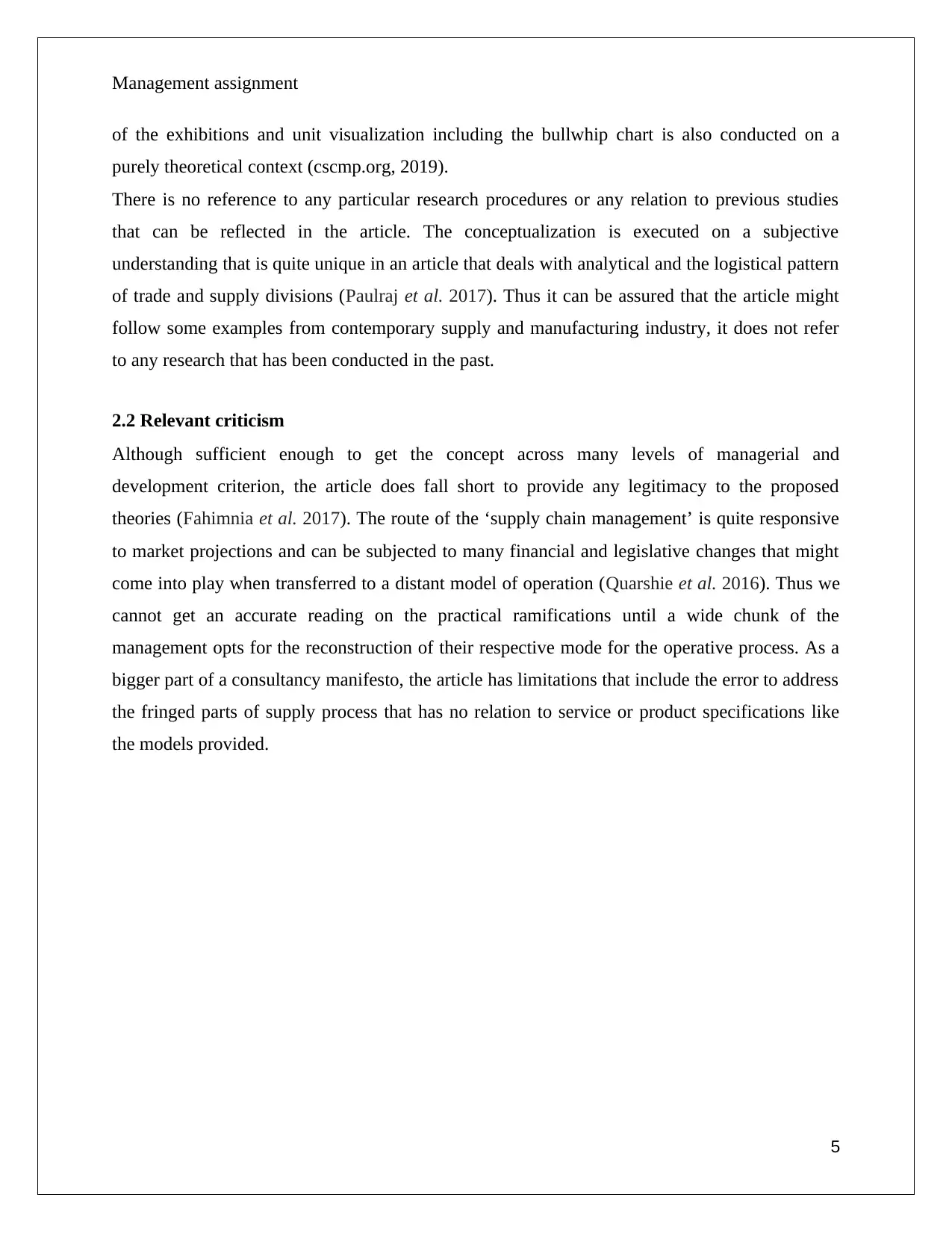
Management assignment
of the exhibitions and unit visualization including the bullwhip chart is also conducted on a
purely theoretical context (cscmp.org, 2019).
There is no reference to any particular research procedures or any relation to previous studies
that can be reflected in the article. The conceptualization is executed on a subjective
understanding that is quite unique in an article that deals with analytical and the logistical pattern
of trade and supply divisions (Paulraj et al. 2017). Thus it can be assured that the article might
follow some examples from contemporary supply and manufacturing industry, it does not refer
to any research that has been conducted in the past.
2.2 Relevant criticism
Although sufficient enough to get the concept across many levels of managerial and
development criterion, the article does fall short to provide any legitimacy to the proposed
theories (Fahimnia et al. 2017). The route of the ‘supply chain management’ is quite responsive
to market projections and can be subjected to many financial and legislative changes that might
come into play when transferred to a distant model of operation (Quarshie et al. 2016). Thus we
cannot get an accurate reading on the practical ramifications until a wide chunk of the
management opts for the reconstruction of their respective mode for the operative process. As a
bigger part of a consultancy manifesto, the article has limitations that include the error to address
the fringed parts of supply process that has no relation to service or product specifications like
the models provided.
5
of the exhibitions and unit visualization including the bullwhip chart is also conducted on a
purely theoretical context (cscmp.org, 2019).
There is no reference to any particular research procedures or any relation to previous studies
that can be reflected in the article. The conceptualization is executed on a subjective
understanding that is quite unique in an article that deals with analytical and the logistical pattern
of trade and supply divisions (Paulraj et al. 2017). Thus it can be assured that the article might
follow some examples from contemporary supply and manufacturing industry, it does not refer
to any research that has been conducted in the past.
2.2 Relevant criticism
Although sufficient enough to get the concept across many levels of managerial and
development criterion, the article does fall short to provide any legitimacy to the proposed
theories (Fahimnia et al. 2017). The route of the ‘supply chain management’ is quite responsive
to market projections and can be subjected to many financial and legislative changes that might
come into play when transferred to a distant model of operation (Quarshie et al. 2016). Thus we
cannot get an accurate reading on the practical ramifications until a wide chunk of the
management opts for the reconstruction of their respective mode for the operative process. As a
bigger part of a consultancy manifesto, the article has limitations that include the error to address
the fringed parts of supply process that has no relation to service or product specifications like
the models provided.
5
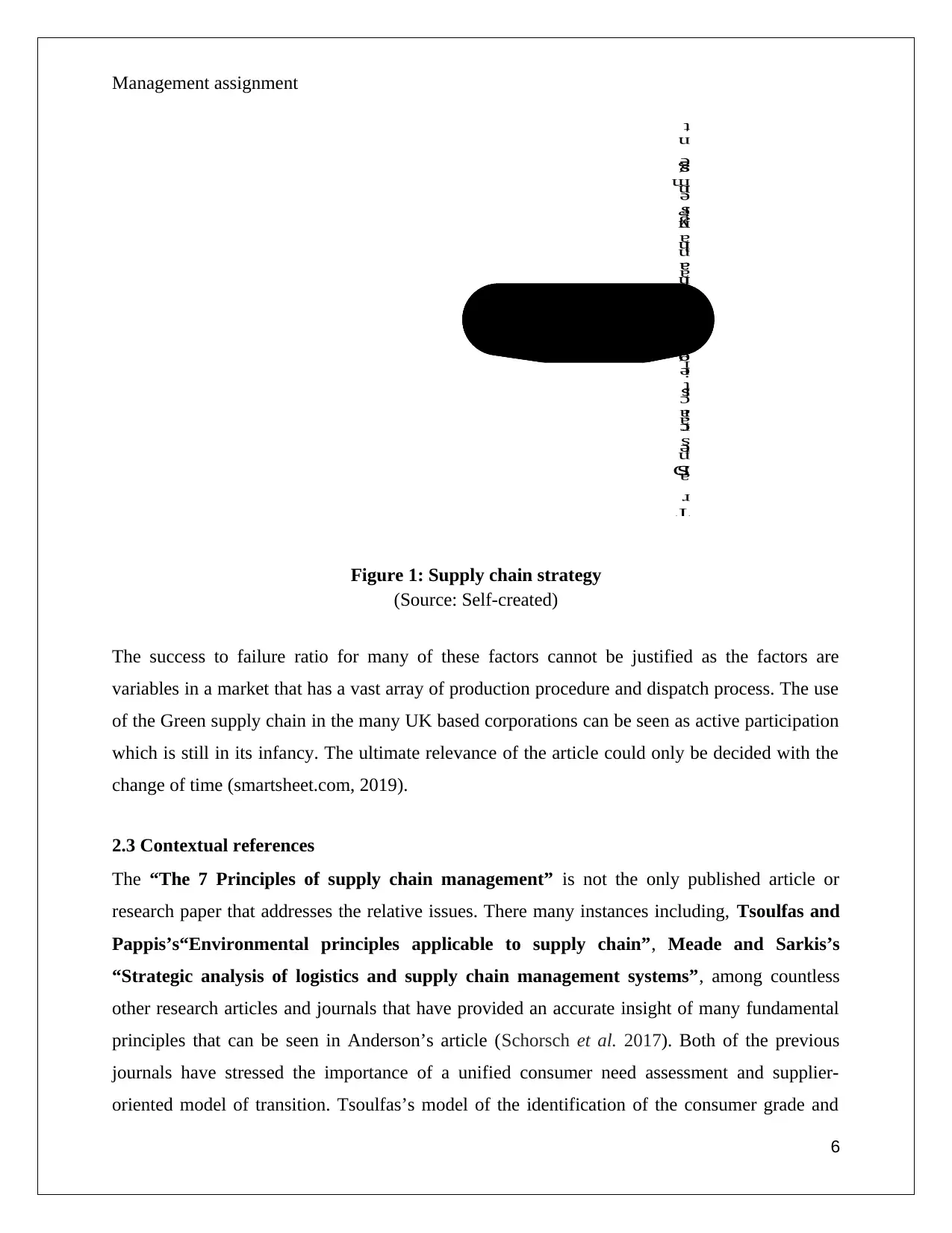
Management assignment
Figure 1: Supply chain strategy
(Source: Self-created)
The success to failure ratio for many of these factors cannot be justified as the factors are
variables in a market that has a vast array of production procedure and dispatch process. The use
of the Green supply chain in the many UK based corporations can be seen as active participation
which is still in its infancy. The ultimate relevance of the article could only be decided with the
change of time (smartsheet.com, 2019).
2.3 Contextual references
The “The 7 Principles of supply chain management” is not the only published article or
research paper that addresses the relative issues. There many instances including, Tsoulfas and
Pappis’s“Environmental principles applicable to supply chain”, Meade and Sarkis’s
“Strategic analysis of logistics and supply chain management systems”, among countless
other research articles and journals that have provided an accurate insight of many fundamental
principles that can be seen in Anderson’s article (Schorsch et al. 2017). Both of the previous
journals have stressed the importance of a unified consumer need assessment and supplier-
oriented model of transition. Tsoulfas’s model of the identification of the consumer grade and
6
S
t
r
a
t
e
g
y
a
n
a
l
y
s
i
s
D
e
c
i
s
i
o
n
p
l
a
n
n
i
n
g
T
r
a
n
s
a
c
t
i
o
n
m
a
n
a
g
e
m
e
n
t
Figure 1: Supply chain strategy
(Source: Self-created)
The success to failure ratio for many of these factors cannot be justified as the factors are
variables in a market that has a vast array of production procedure and dispatch process. The use
of the Green supply chain in the many UK based corporations can be seen as active participation
which is still in its infancy. The ultimate relevance of the article could only be decided with the
change of time (smartsheet.com, 2019).
2.3 Contextual references
The “The 7 Principles of supply chain management” is not the only published article or
research paper that addresses the relative issues. There many instances including, Tsoulfas and
Pappis’s“Environmental principles applicable to supply chain”, Meade and Sarkis’s
“Strategic analysis of logistics and supply chain management systems”, among countless
other research articles and journals that have provided an accurate insight of many fundamental
principles that can be seen in Anderson’s article (Schorsch et al. 2017). Both of the previous
journals have stressed the importance of a unified consumer need assessment and supplier-
oriented model of transition. Tsoulfas’s model of the identification of the consumer grade and
6
S
t
r
a
t
e
g
y
a
n
a
l
y
s
i
s
D
e
c
i
s
i
o
n
p
l
a
n
n
i
n
g
T
r
a
n
s
a
c
t
i
o
n
m
a
n
a
g
e
m
e
n
t
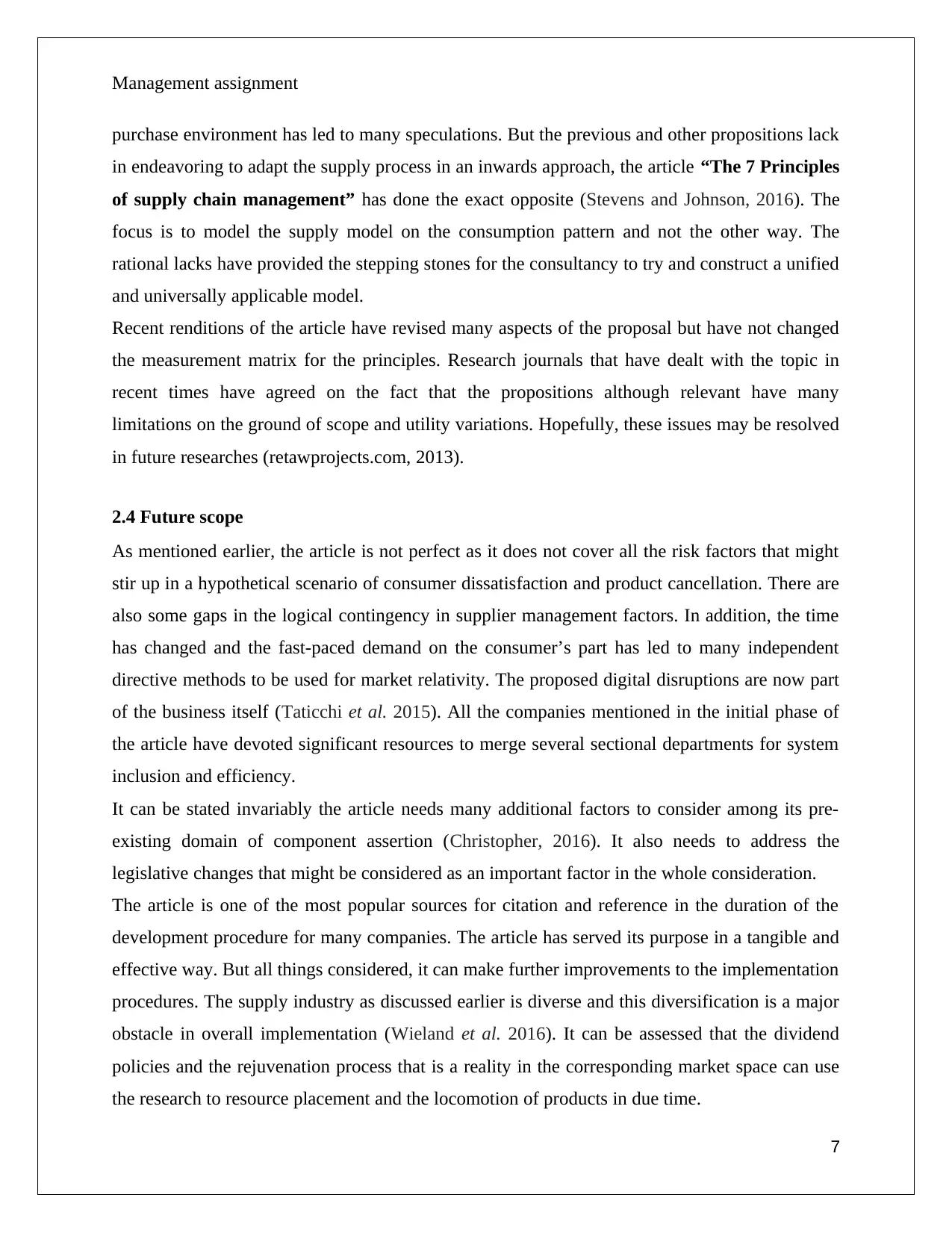
Management assignment
purchase environment has led to many speculations. But the previous and other propositions lack
in endeavoring to adapt the supply process in an inwards approach, the article “The 7 Principles
of supply chain management” has done the exact opposite (Stevens and Johnson, 2016). The
focus is to model the supply model on the consumption pattern and not the other way. The
rational lacks have provided the stepping stones for the consultancy to try and construct a unified
and universally applicable model.
Recent renditions of the article have revised many aspects of the proposal but have not changed
the measurement matrix for the principles. Research journals that have dealt with the topic in
recent times have agreed on the fact that the propositions although relevant have many
limitations on the ground of scope and utility variations. Hopefully, these issues may be resolved
in future researches (retawprojects.com, 2013).
2.4 Future scope
As mentioned earlier, the article is not perfect as it does not cover all the risk factors that might
stir up in a hypothetical scenario of consumer dissatisfaction and product cancellation. There are
also some gaps in the logical contingency in supplier management factors. In addition, the time
has changed and the fast-paced demand on the consumer’s part has led to many independent
directive methods to be used for market relativity. The proposed digital disruptions are now part
of the business itself (Taticchi et al. 2015). All the companies mentioned in the initial phase of
the article have devoted significant resources to merge several sectional departments for system
inclusion and efficiency.
It can be stated invariably the article needs many additional factors to consider among its pre-
existing domain of component assertion (Christopher, 2016). It also needs to address the
legislative changes that might be considered as an important factor in the whole consideration.
The article is one of the most popular sources for citation and reference in the duration of the
development procedure for many companies. The article has served its purpose in a tangible and
effective way. But all things considered, it can make further improvements to the implementation
procedures. The supply industry as discussed earlier is diverse and this diversification is a major
obstacle in overall implementation (Wieland et al. 2016). It can be assessed that the dividend
policies and the rejuvenation process that is a reality in the corresponding market space can use
the research to resource placement and the locomotion of products in due time.
7
purchase environment has led to many speculations. But the previous and other propositions lack
in endeavoring to adapt the supply process in an inwards approach, the article “The 7 Principles
of supply chain management” has done the exact opposite (Stevens and Johnson, 2016). The
focus is to model the supply model on the consumption pattern and not the other way. The
rational lacks have provided the stepping stones for the consultancy to try and construct a unified
and universally applicable model.
Recent renditions of the article have revised many aspects of the proposal but have not changed
the measurement matrix for the principles. Research journals that have dealt with the topic in
recent times have agreed on the fact that the propositions although relevant have many
limitations on the ground of scope and utility variations. Hopefully, these issues may be resolved
in future researches (retawprojects.com, 2013).
2.4 Future scope
As mentioned earlier, the article is not perfect as it does not cover all the risk factors that might
stir up in a hypothetical scenario of consumer dissatisfaction and product cancellation. There are
also some gaps in the logical contingency in supplier management factors. In addition, the time
has changed and the fast-paced demand on the consumer’s part has led to many independent
directive methods to be used for market relativity. The proposed digital disruptions are now part
of the business itself (Taticchi et al. 2015). All the companies mentioned in the initial phase of
the article have devoted significant resources to merge several sectional departments for system
inclusion and efficiency.
It can be stated invariably the article needs many additional factors to consider among its pre-
existing domain of component assertion (Christopher, 2016). It also needs to address the
legislative changes that might be considered as an important factor in the whole consideration.
The article is one of the most popular sources for citation and reference in the duration of the
development procedure for many companies. The article has served its purpose in a tangible and
effective way. But all things considered, it can make further improvements to the implementation
procedures. The supply industry as discussed earlier is diverse and this diversification is a major
obstacle in overall implementation (Wieland et al. 2016). It can be assessed that the dividend
policies and the rejuvenation process that is a reality in the corresponding market space can use
the research to resource placement and the locomotion of products in due time.
7
Paraphrase This Document
Need a fresh take? Get an instant paraphrase of this document with our AI Paraphraser
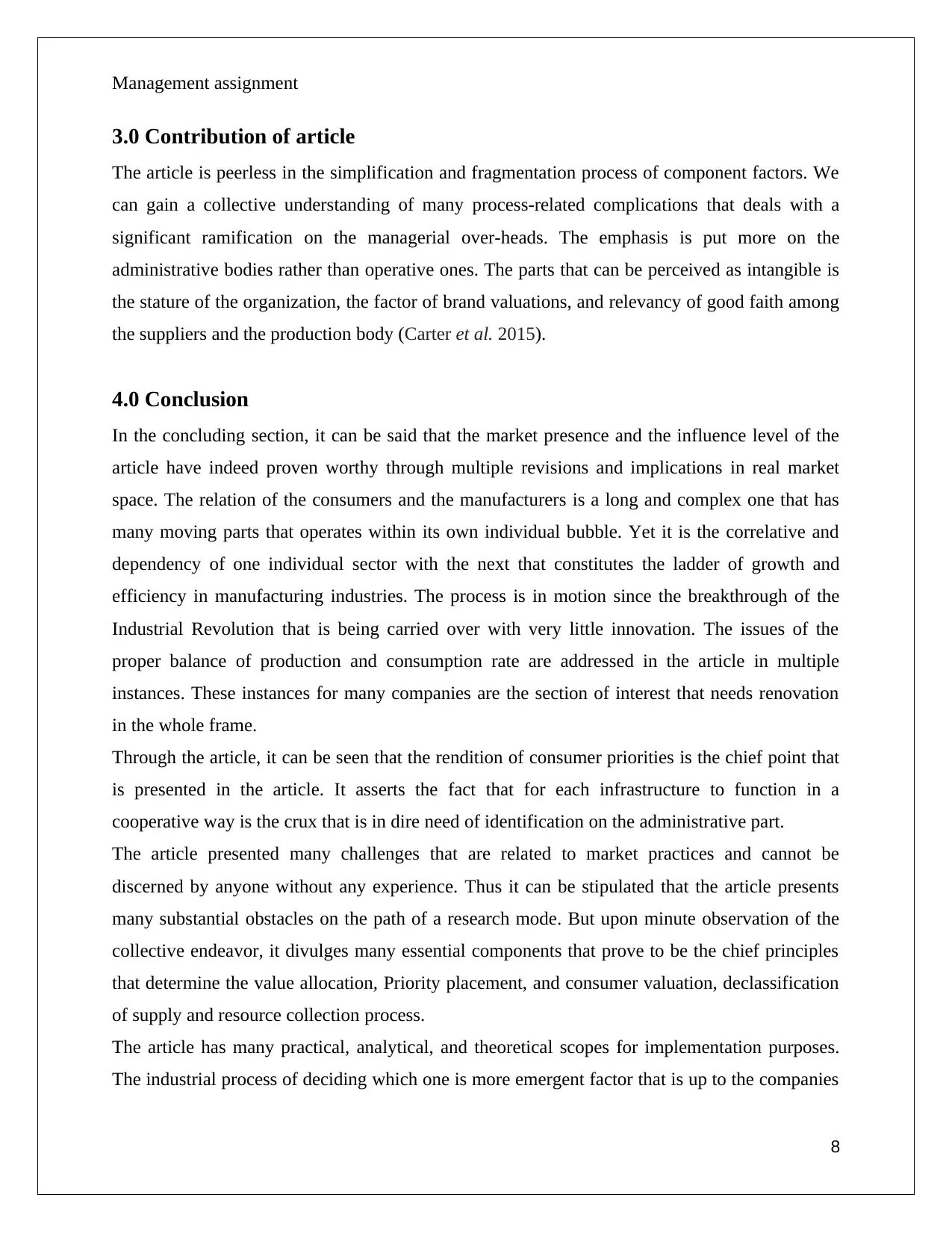
Management assignment
3.0 Contribution of article
The article is peerless in the simplification and fragmentation process of component factors. We
can gain a collective understanding of many process-related complications that deals with a
significant ramification on the managerial over-heads. The emphasis is put more on the
administrative bodies rather than operative ones. The parts that can be perceived as intangible is
the stature of the organization, the factor of brand valuations, and relevancy of good faith among
the suppliers and the production body (Carter et al. 2015).
4.0 Conclusion
In the concluding section, it can be said that the market presence and the influence level of the
article have indeed proven worthy through multiple revisions and implications in real market
space. The relation of the consumers and the manufacturers is a long and complex one that has
many moving parts that operates within its own individual bubble. Yet it is the correlative and
dependency of one individual sector with the next that constitutes the ladder of growth and
efficiency in manufacturing industries. The process is in motion since the breakthrough of the
Industrial Revolution that is being carried over with very little innovation. The issues of the
proper balance of production and consumption rate are addressed in the article in multiple
instances. These instances for many companies are the section of interest that needs renovation
in the whole frame.
Through the article, it can be seen that the rendition of consumer priorities is the chief point that
is presented in the article. It asserts the fact that for each infrastructure to function in a
cooperative way is the crux that is in dire need of identification on the administrative part.
The article presented many challenges that are related to market practices and cannot be
discerned by anyone without any experience. Thus it can be stipulated that the article presents
many substantial obstacles on the path of a research mode. But upon minute observation of the
collective endeavor, it divulges many essential components that prove to be the chief principles
that determine the value allocation, Priority placement, and consumer valuation, declassification
of supply and resource collection process.
The article has many practical, analytical, and theoretical scopes for implementation purposes.
The industrial process of deciding which one is more emergent factor that is up to the companies
8
3.0 Contribution of article
The article is peerless in the simplification and fragmentation process of component factors. We
can gain a collective understanding of many process-related complications that deals with a
significant ramification on the managerial over-heads. The emphasis is put more on the
administrative bodies rather than operative ones. The parts that can be perceived as intangible is
the stature of the organization, the factor of brand valuations, and relevancy of good faith among
the suppliers and the production body (Carter et al. 2015).
4.0 Conclusion
In the concluding section, it can be said that the market presence and the influence level of the
article have indeed proven worthy through multiple revisions and implications in real market
space. The relation of the consumers and the manufacturers is a long and complex one that has
many moving parts that operates within its own individual bubble. Yet it is the correlative and
dependency of one individual sector with the next that constitutes the ladder of growth and
efficiency in manufacturing industries. The process is in motion since the breakthrough of the
Industrial Revolution that is being carried over with very little innovation. The issues of the
proper balance of production and consumption rate are addressed in the article in multiple
instances. These instances for many companies are the section of interest that needs renovation
in the whole frame.
Through the article, it can be seen that the rendition of consumer priorities is the chief point that
is presented in the article. It asserts the fact that for each infrastructure to function in a
cooperative way is the crux that is in dire need of identification on the administrative part.
The article presented many challenges that are related to market practices and cannot be
discerned by anyone without any experience. Thus it can be stipulated that the article presents
many substantial obstacles on the path of a research mode. But upon minute observation of the
collective endeavor, it divulges many essential components that prove to be the chief principles
that determine the value allocation, Priority placement, and consumer valuation, declassification
of supply and resource collection process.
The article has many practical, analytical, and theoretical scopes for implementation purposes.
The industrial process of deciding which one is more emergent factor that is up to the companies
8
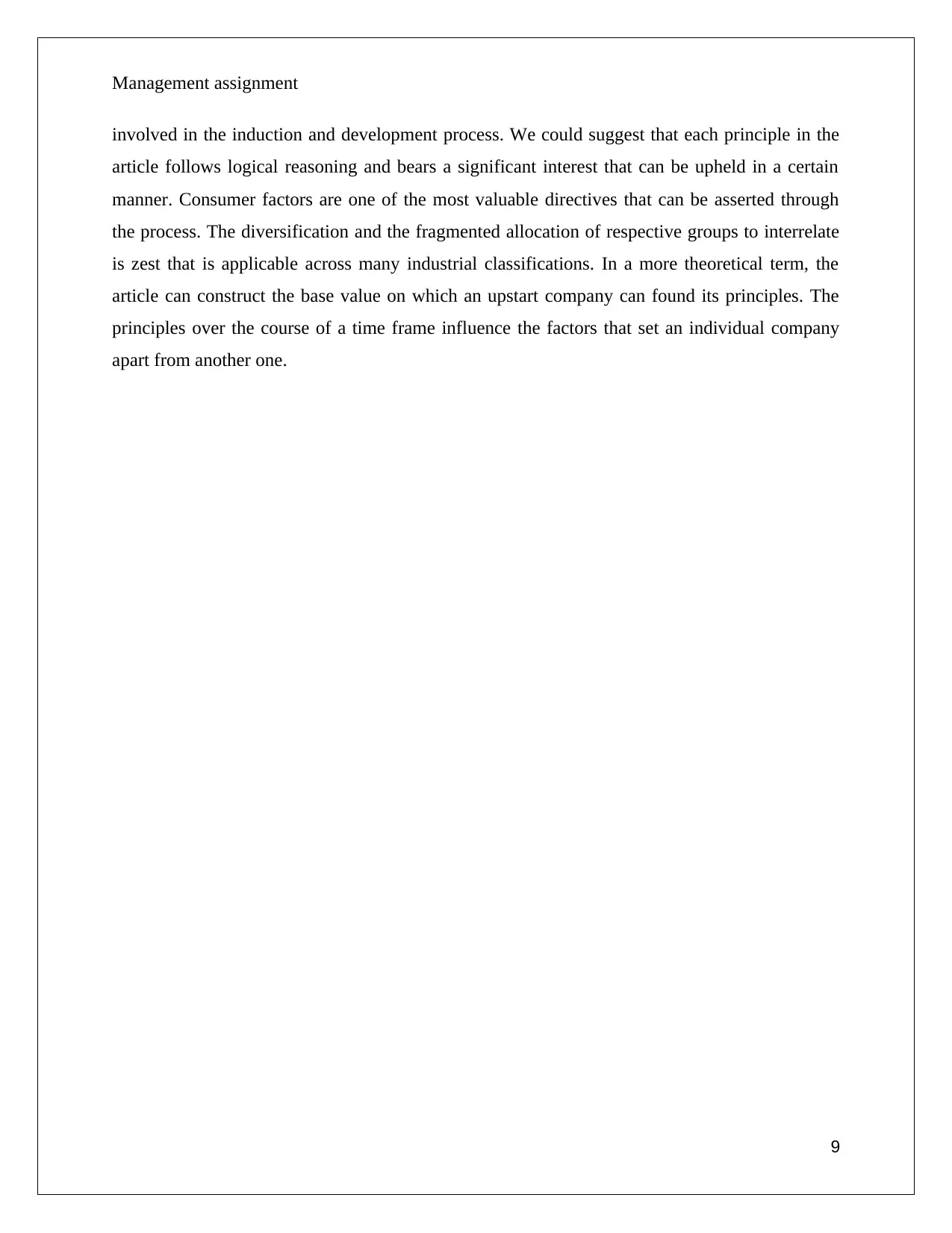
Management assignment
involved in the induction and development process. We could suggest that each principle in the
article follows logical reasoning and bears a significant interest that can be upheld in a certain
manner. Consumer factors are one of the most valuable directives that can be asserted through
the process. The diversification and the fragmented allocation of respective groups to interrelate
is zest that is applicable across many industrial classifications. In a more theoretical term, the
article can construct the base value on which an upstart company can found its principles. The
principles over the course of a time frame influence the factors that set an individual company
apart from another one.
9
involved in the induction and development process. We could suggest that each principle in the
article follows logical reasoning and bears a significant interest that can be upheld in a certain
manner. Consumer factors are one of the most valuable directives that can be asserted through
the process. The diversification and the fragmented allocation of respective groups to interrelate
is zest that is applicable across many industrial classifications. In a more theoretical term, the
article can construct the base value on which an upstart company can found its principles. The
principles over the course of a time frame influence the factors that set an individual company
apart from another one.
9
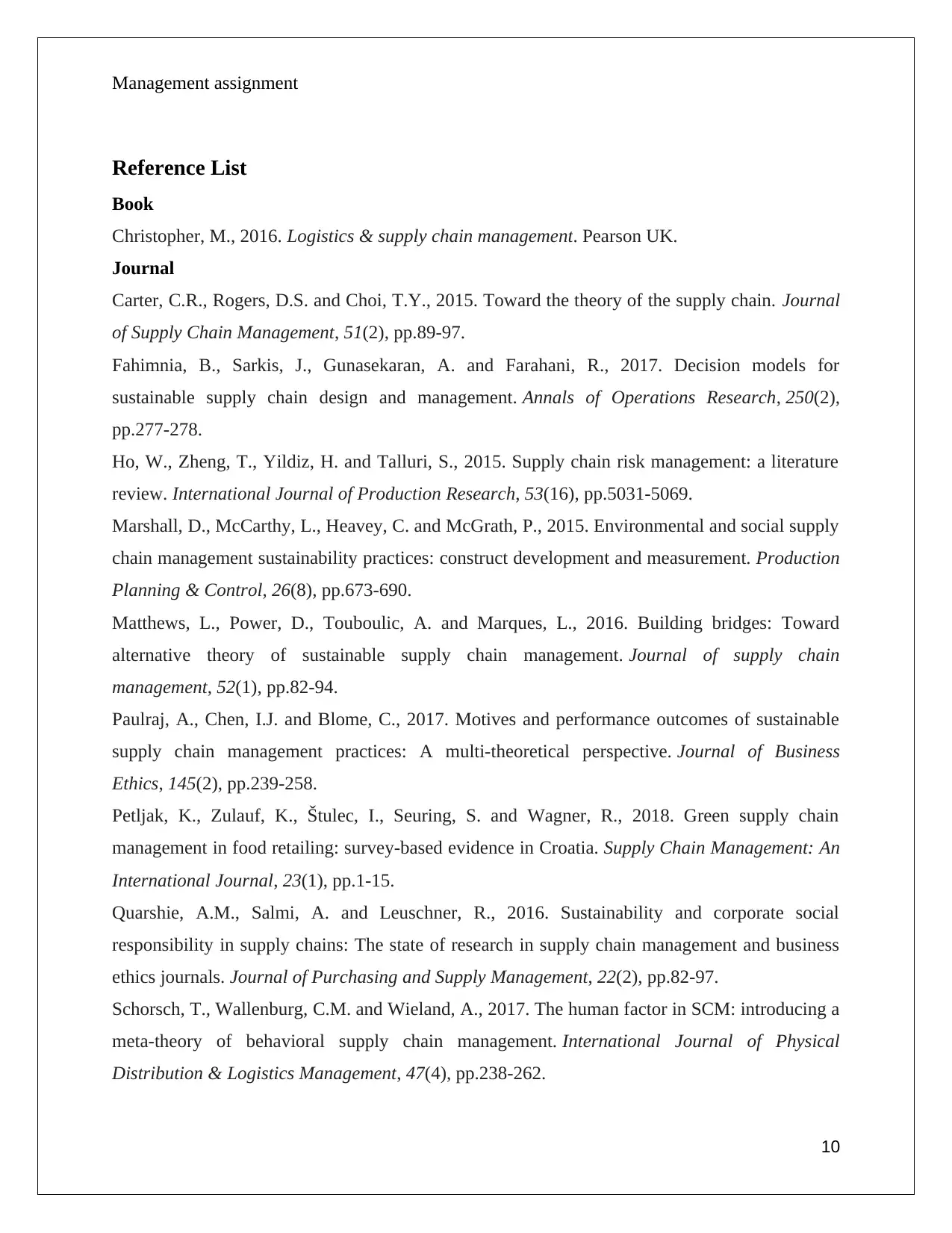
Management assignment
Reference List
Book
Christopher, M., 2016. Logistics & supply chain management. Pearson UK.
Journal
Carter, C.R., Rogers, D.S. and Choi, T.Y., 2015. Toward the theory of the supply chain. Journal
of Supply Chain Management, 51(2), pp.89-97.
Fahimnia, B., Sarkis, J., Gunasekaran, A. and Farahani, R., 2017. Decision models for
sustainable supply chain design and management. Annals of Operations Research, 250(2),
pp.277-278.
Ho, W., Zheng, T., Yildiz, H. and Talluri, S., 2015. Supply chain risk management: a literature
review. International Journal of Production Research, 53(16), pp.5031-5069.
Marshall, D., McCarthy, L., Heavey, C. and McGrath, P., 2015. Environmental and social supply
chain management sustainability practices: construct development and measurement. Production
Planning & Control, 26(8), pp.673-690.
Matthews, L., Power, D., Touboulic, A. and Marques, L., 2016. Building bridges: Toward
alternative theory of sustainable supply chain management. Journal of supply chain
management, 52(1), pp.82-94.
Paulraj, A., Chen, I.J. and Blome, C., 2017. Motives and performance outcomes of sustainable
supply chain management practices: A multi-theoretical perspective. Journal of Business
Ethics, 145(2), pp.239-258.
Petljak, K., Zulauf, K., Štulec, I., Seuring, S. and Wagner, R., 2018. Green supply chain
management in food retailing: survey-based evidence in Croatia. Supply Chain Management: An
International Journal, 23(1), pp.1-15.
Quarshie, A.M., Salmi, A. and Leuschner, R., 2016. Sustainability and corporate social
responsibility in supply chains: The state of research in supply chain management and business
ethics journals. Journal of Purchasing and Supply Management, 22(2), pp.82-97.
Schorsch, T., Wallenburg, C.M. and Wieland, A., 2017. The human factor in SCM: introducing a
meta-theory of behavioral supply chain management. International Journal of Physical
Distribution & Logistics Management, 47(4), pp.238-262.
10
Reference List
Book
Christopher, M., 2016. Logistics & supply chain management. Pearson UK.
Journal
Carter, C.R., Rogers, D.S. and Choi, T.Y., 2015. Toward the theory of the supply chain. Journal
of Supply Chain Management, 51(2), pp.89-97.
Fahimnia, B., Sarkis, J., Gunasekaran, A. and Farahani, R., 2017. Decision models for
sustainable supply chain design and management. Annals of Operations Research, 250(2),
pp.277-278.
Ho, W., Zheng, T., Yildiz, H. and Talluri, S., 2015. Supply chain risk management: a literature
review. International Journal of Production Research, 53(16), pp.5031-5069.
Marshall, D., McCarthy, L., Heavey, C. and McGrath, P., 2015. Environmental and social supply
chain management sustainability practices: construct development and measurement. Production
Planning & Control, 26(8), pp.673-690.
Matthews, L., Power, D., Touboulic, A. and Marques, L., 2016. Building bridges: Toward
alternative theory of sustainable supply chain management. Journal of supply chain
management, 52(1), pp.82-94.
Paulraj, A., Chen, I.J. and Blome, C., 2017. Motives and performance outcomes of sustainable
supply chain management practices: A multi-theoretical perspective. Journal of Business
Ethics, 145(2), pp.239-258.
Petljak, K., Zulauf, K., Štulec, I., Seuring, S. and Wagner, R., 2018. Green supply chain
management in food retailing: survey-based evidence in Croatia. Supply Chain Management: An
International Journal, 23(1), pp.1-15.
Quarshie, A.M., Salmi, A. and Leuschner, R., 2016. Sustainability and corporate social
responsibility in supply chains: The state of research in supply chain management and business
ethics journals. Journal of Purchasing and Supply Management, 22(2), pp.82-97.
Schorsch, T., Wallenburg, C.M. and Wieland, A., 2017. The human factor in SCM: introducing a
meta-theory of behavioral supply chain management. International Journal of Physical
Distribution & Logistics Management, 47(4), pp.238-262.
10
Secure Best Marks with AI Grader
Need help grading? Try our AI Grader for instant feedback on your assignments.
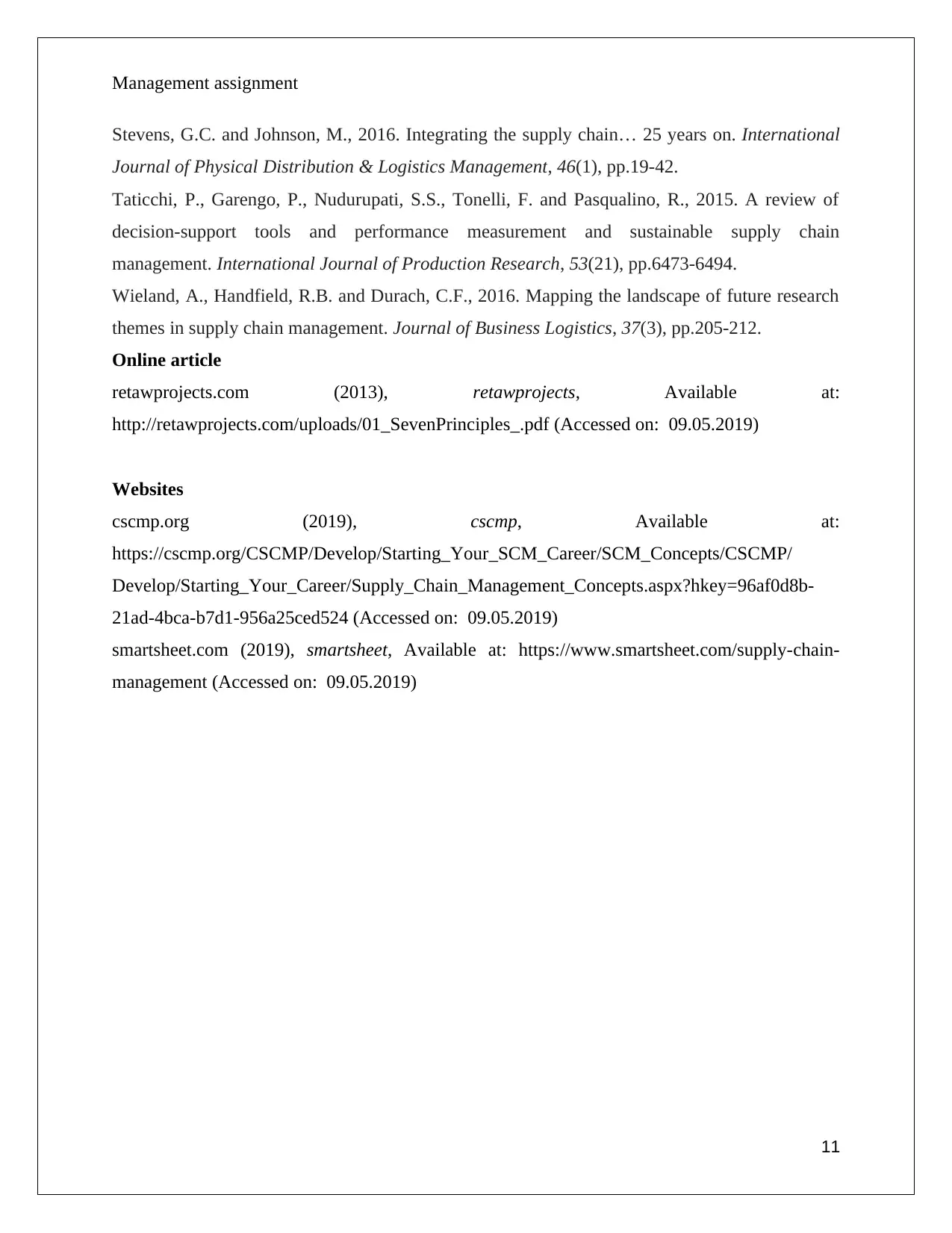
Management assignment
Stevens, G.C. and Johnson, M., 2016. Integrating the supply chain… 25 years on. International
Journal of Physical Distribution & Logistics Management, 46(1), pp.19-42.
Taticchi, P., Garengo, P., Nudurupati, S.S., Tonelli, F. and Pasqualino, R., 2015. A review of
decision-support tools and performance measurement and sustainable supply chain
management. International Journal of Production Research, 53(21), pp.6473-6494.
Wieland, A., Handfield, R.B. and Durach, C.F., 2016. Mapping the landscape of future research
themes in supply chain management. Journal of Business Logistics, 37(3), pp.205-212.
Online article
retawprojects.com (2013), retawprojects, Available at:
http://retawprojects.com/uploads/01_SevenPrinciples_.pdf (Accessed on: 09.05.2019)
Websites
cscmp.org (2019), cscmp, Available at:
https://cscmp.org/CSCMP/Develop/Starting_Your_SCM_Career/SCM_Concepts/CSCMP/
Develop/Starting_Your_Career/Supply_Chain_Management_Concepts.aspx?hkey=96af0d8b-
21ad-4bca-b7d1-956a25ced524 (Accessed on: 09.05.2019)
smartsheet.com (2019), smartsheet, Available at: https://www.smartsheet.com/supply-chain-
management (Accessed on: 09.05.2019)
11
Stevens, G.C. and Johnson, M., 2016. Integrating the supply chain… 25 years on. International
Journal of Physical Distribution & Logistics Management, 46(1), pp.19-42.
Taticchi, P., Garengo, P., Nudurupati, S.S., Tonelli, F. and Pasqualino, R., 2015. A review of
decision-support tools and performance measurement and sustainable supply chain
management. International Journal of Production Research, 53(21), pp.6473-6494.
Wieland, A., Handfield, R.B. and Durach, C.F., 2016. Mapping the landscape of future research
themes in supply chain management. Journal of Business Logistics, 37(3), pp.205-212.
Online article
retawprojects.com (2013), retawprojects, Available at:
http://retawprojects.com/uploads/01_SevenPrinciples_.pdf (Accessed on: 09.05.2019)
Websites
cscmp.org (2019), cscmp, Available at:
https://cscmp.org/CSCMP/Develop/Starting_Your_SCM_Career/SCM_Concepts/CSCMP/
Develop/Starting_Your_Career/Supply_Chain_Management_Concepts.aspx?hkey=96af0d8b-
21ad-4bca-b7d1-956a25ced524 (Accessed on: 09.05.2019)
smartsheet.com (2019), smartsheet, Available at: https://www.smartsheet.com/supply-chain-
management (Accessed on: 09.05.2019)
11
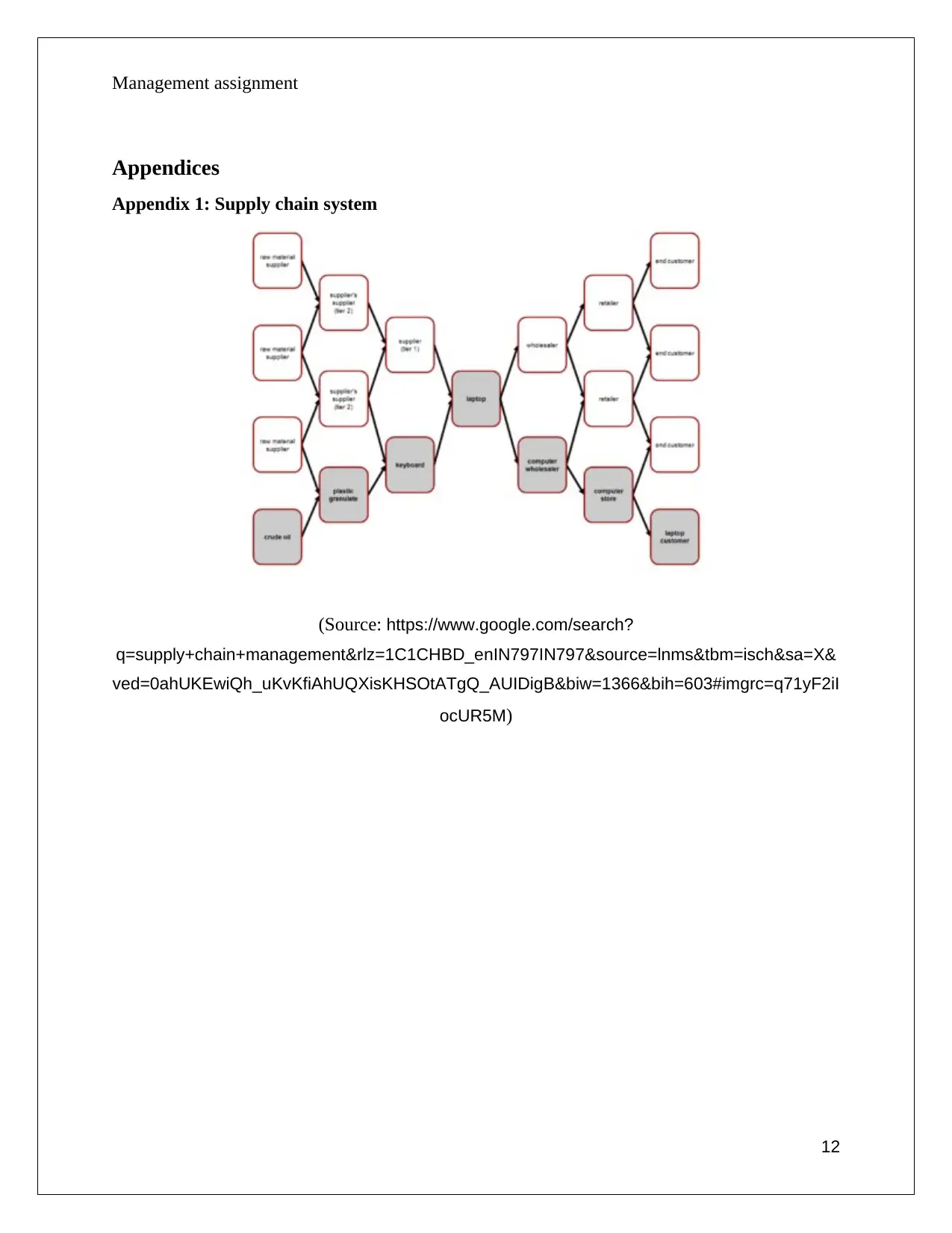
Management assignment
Appendices
Appendix 1: Supply chain system
(Source: https://www.google.com/search?
q=supply+chain+management&rlz=1C1CHBD_enIN797IN797&source=lnms&tbm=isch&sa=X&
ved=0ahUKEwiQh_uKvKfiAhUQXisKHSOtATgQ_AUIDigB&biw=1366&bih=603#imgrc=q71yF2iI
ocUR5M)
12
Appendices
Appendix 1: Supply chain system
(Source: https://www.google.com/search?
q=supply+chain+management&rlz=1C1CHBD_enIN797IN797&source=lnms&tbm=isch&sa=X&
ved=0ahUKEwiQh_uKvKfiAhUQXisKHSOtATgQ_AUIDigB&biw=1366&bih=603#imgrc=q71yF2iI
ocUR5M)
12
1 out of 12
Related Documents
Your All-in-One AI-Powered Toolkit for Academic Success.
+13062052269
info@desklib.com
Available 24*7 on WhatsApp / Email
![[object Object]](/_next/static/media/star-bottom.7253800d.svg)
Unlock your academic potential
© 2024 | Zucol Services PVT LTD | All rights reserved.




